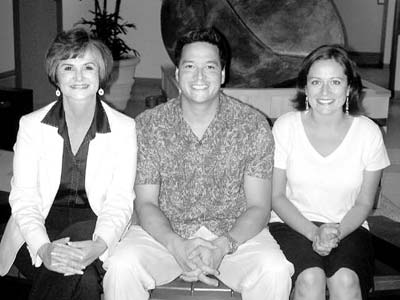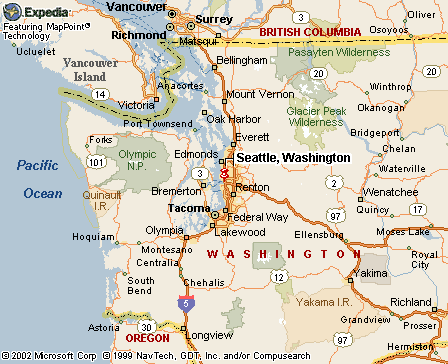|
|
Canku Ota |
|
|
(Many Paths) |
||
|
An Online Newsletter Celebrating Native America |
||
|
December 28, 2002 - Issue 77 |
||
|
|
||
|
Gates Foundation Pilot Program Fights Dropouts |
||
|
by Stephanie Woodard / Today Correspondent
/ Indian Country Today
|
||
|
|
 SEATTLE,
WA - The Early College High School Program is gearing up to accept a
second round of applicants from Washington State Native communities
or public schools with a high proportion of Indian students. The program
is part of a nationwide effort on the part of the Bill & Melinda
Gates Foundation and others to help disadvantaged children improve graduation
rates and move into higher education. Over the next two years, five
to six schools will join Medicine Wheel Academy in Spokane, Wash., Ferndale
High School in Ferndale, Wash. and Tulalip Heritage School in Marysville,
Wash. SEATTLE,
WA - The Early College High School Program is gearing up to accept a
second round of applicants from Washington State Native communities
or public schools with a high proportion of Indian students. The program
is part of a nationwide effort on the part of the Bill & Melinda
Gates Foundation and others to help disadvantaged children improve graduation
rates and move into higher education. Over the next two years, five
to six schools will join Medicine Wheel Academy in Spokane, Wash., Ferndale
High School in Ferndale, Wash. and Tulalip Heritage School in Marysville,
Wash. The three schools that are already online are in their first-year planning phase; they will open their doors to students in fall 2003. Funding for any given school is for a total of three years. Eventually, students graduate with both high school diplomas and associate of arts degrees. Mentoring and other support is intended to help them move on to further education and rewarding careers. "The program has the potential to make higher education the norm, rather than something unusual in Indian communities," says Keith Egawa, Lummi, the initiative’s Community Engagement Specialist. Currently, Native students have the highest K-12 dropout rates and the lowest college-completion rates of any ethnic group in the country, according to the National Education Association and the National Indian Education Association. Dropping out has a devastating impact on future earnings, since unemployment for those who did not graduate from high school, at 6.5 percent, is more than three times the rate for those with a college degree, according to the Bureau of Labor Statistics. Similarly, the Bureau reports, earnings of college graduates are, on average, more than double those of high-school dropouts. "Dropping out of high school remands young people to a life of struggle and poverty," said Tom Vander Ark, executive director of education for the Bill & Melinda Gates Foundation. "When we lose one student, it’s one too many." The Gates Foundation has kicked in $40 million to fund the Early College High School Program; Carnegie Corp., the Ford Foundation and the W.K. Kellogg Foundation have provided additional smaller amounts. Antioch University was chosen as the intermediary to work with Native students because of its successful track record with local tribes. Antioch has offered reservation-based degree programs, supported Native language teachers and hosted American Indian education conferences. Other groups are acting as intermediaries in other parts of the country, overseeing primarily urban programs. "The idea of early college has been around for years," says Carmon Cunningham, vice president of Jobs for the Future, a Boston-based research, consulting and advocacy group that is another one of the intermediaries. "We, as an organization, have been talking for a long time about what’s wrong with education in this country, especially for low-income youth. There are many communities that have not been well served, and that includes Native people. So it made sense to include them in the program." "School districts and tribes in our area have already approached us about applying for the second round," says Linda Campbell, Ph.D., Mohawk, a professor in the Antioch Education Department and project director of the initiative. "Successful proposals will include integration of local culture, year-round learning, opportunities for tutoring and other academic support and mentoring from role models in the community. To generate the expertise necessary to teach the advanced courses, the secondary school has to partner with an institution of higher education, such as a tribal college, a community college or a four-year institution." "When you look at the tribes that are interested," says Geneva Wortman, Yurok, project policy coordinator, "you see that they have a strategic vision for the role of education in their communities. They’re economically viable; they’ve created jobs and they need to fill them with people who are culturally aware." "We expect graduates to move into both the mainstream job market and the tribal job market," added Campbell. "There’s a special need among our tribes for people with entrepreneurial skills, as well as for those with expertise in human services, teaching, medicine and natural resources. In Washington State, we have tribes that are very much in a growth mode; for example, the Tulalip and Muckleshoot tribes are each the second-largest employers in their respective counties. And, of course, they have a strong interest in employing more Native experts." Egawa said that one of the first steps in getting the schools up and running to make sure the community is fully engaged. "Each school has to figure out how to bring parents, extended family, elders, and health and social services employees on board," he explained. "That way, the curriculum we’re designing this year will reflect the local culture - its history and values - when the kids show up for classes next year." Involvement of the various entities also removes the borders between home and school, according to Egawa. "All the partners are available to address particular needs individual students may have for daycare, health care, counseling and so on. There are no models for exactly what we are doing, so we’re figuring it out as we go along. Each school will start with a steering committee that will craft an approach for identifying and solving students’ problems." Currently, the Native American facet of the national program is confined to Washington State, although success with the model may mean expansion at some point. According to Campbell, "Tribes and school districts with high Native populations nationwide have expressed an interest in the project. At this point, the Gates Foundation is considering further funding, but no decision has been made. They may wish to see the results from our pilot program before proceeding." Applications for the Early College High School Program are available on the web site http://www.antiochsea.edu/earlycollege. A streamlined version of the application will be posted in January. The deadline is in April 2003.
|
|
|
||
|
|
||
| Canku Ota is a free Newsletter celebrating Native America, its traditions and accomplishments . We do not provide subscriber or visitor names to anyone. Some articles presented in Canku Ota may contain copyright material. We have received appropriate permissions for republishing any articles. Material appearing here is distributed without profit or monetary gain to those who have expressed an interest. This is in accordance with Title 17 U.S.C. section 107. | ||
|
Canku Ota is a copyright © 2000, 2001, 2002 of Vicki Lockard and Paul Barry. |
||
 |
 |
|
|
The "Canku Ota - A Newsletter Celebrating Native America" web site and its design is the |
||
|
Copyright © 1999, 2000, 2001, 2002 of Paul C. Barry. |
||
|
All Rights Reserved. |
||
